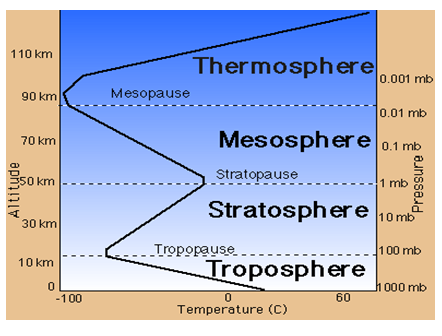Troposphere:
- Layer nearest to earth’s surface. Thickness varies from 8 km at the poles to 16 km at the equator.
- All weather phenomenons occur here.
- Densest of all and contains water vapour, moisture and dust.
- Dust particles present in this layer hold the water vapour and contribute to the occurrence of twilight and the red colours of sunlight and sunset.
- In this, at every 165 m there is a drop of 1°c (or 6.4°c per km). This is called Normal Lapse Rate of Temperature.
- Tropopause separates troposphere from stratosphere.

Stratosphere:
- Extends from 16 km to 50 km ht. The temperature ceases to fall with the increase of height in this layer.
- Little weather is generated here as there is very little water vapour and virtually no dust present.
- Stratosphere provides ideal conditions for flying large airplanes.
- Contains ozone (25-30 km from earth’s surface), region being called Ozonosphere. It absorbs the ultra-violet rays from the sun. This layer has a comparatively higher temperature due to the absorption of ultra-violet radiation from the sun (temperature increases as we go up).
Mesosphere:
- It extends till 80–85 km.
- It is the coldest place on Earth and has an average temperature around −85 degree celcius.
Thermosphere:
- Extends to about 80-600 km.
- Also protects earth from harmful radiation. This causes increase in temperature with height in this layer.
- It also protects earth from falling meteorites, as most of them burn out in this region.
Exosphere:
- Here the earth’s gravity is extremely weak.
- Upper limit quite uncertain.
- The outer part is called Magnetosphere.
The ionized particles increase in frequency with increasing heights. There are 2 belts in the upper atmosphere having a high concentration of ionized particles. They are known as Van Allen’s Radiation Belts. The inner belt lies about 2600 km from the earth’s surface, while the outer lies at about 13,000 to 19,000 km from it. These belts represent concentrations of highly charged particles, protons and electrons from the sun, trapped within lines of force of the earth’s external magnetic field- the Magnetosphere.
AffairsCloud Recommends Oliveboard Mock Test
AffairsCloud Ebook - Support Us to Grow
Govt Jobs by Category
Bank Jobs Notification




